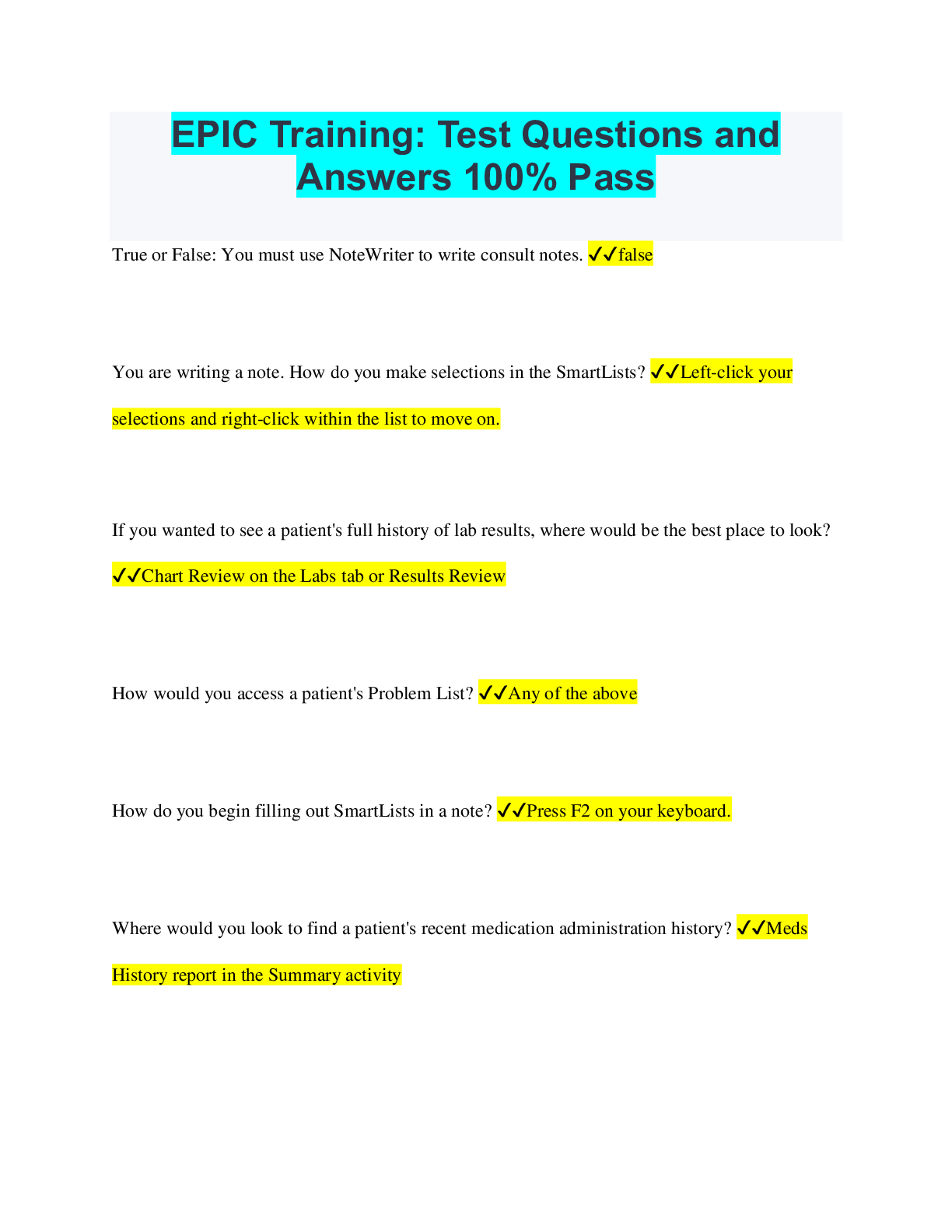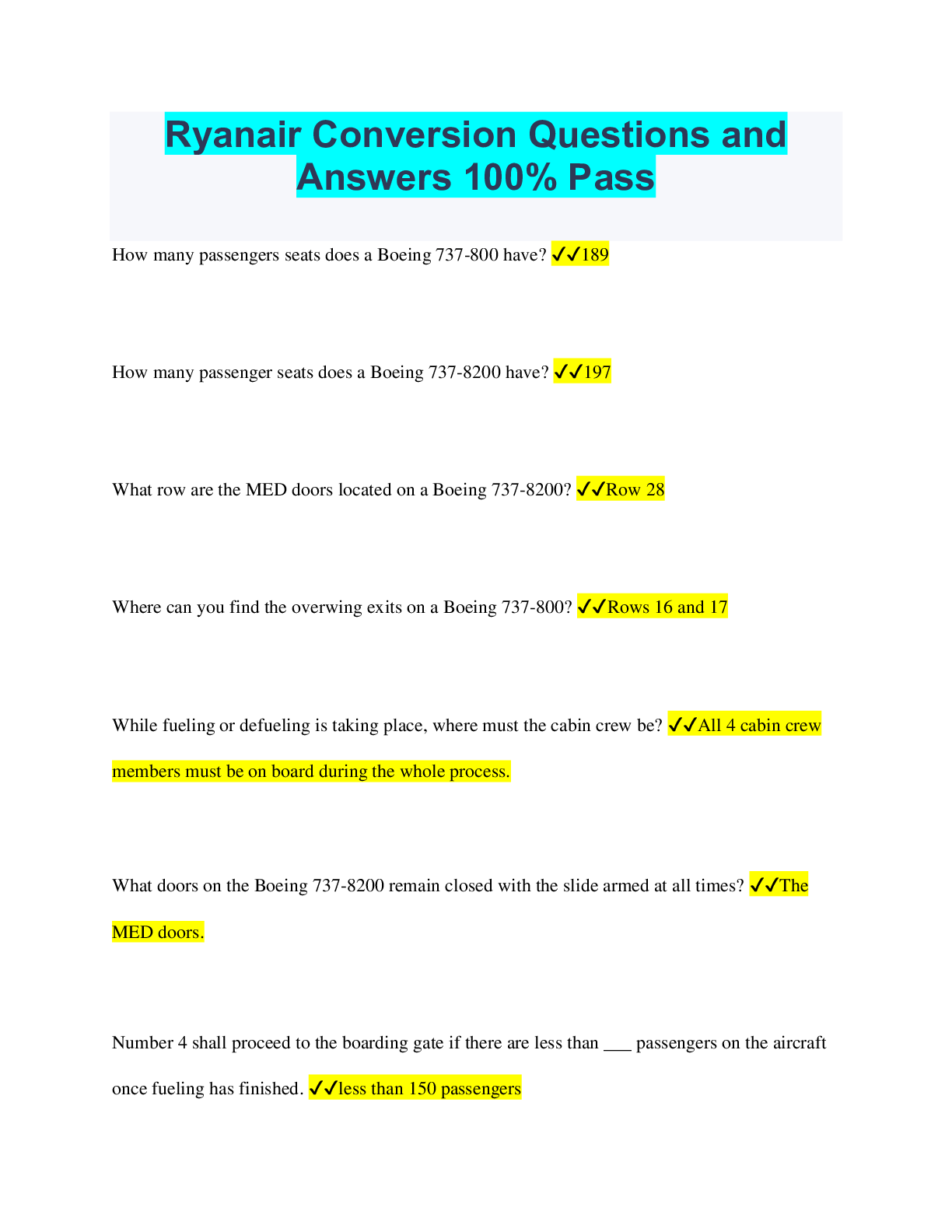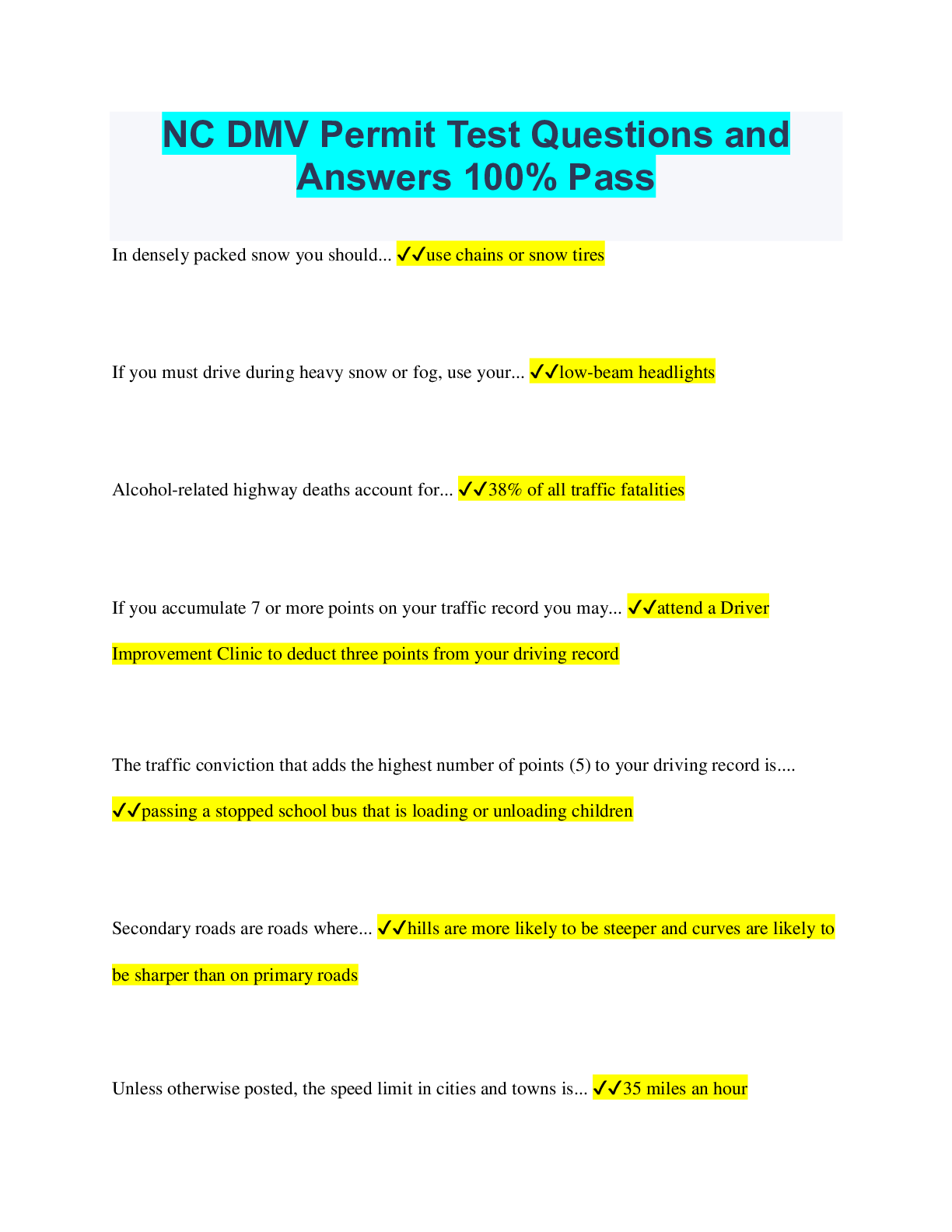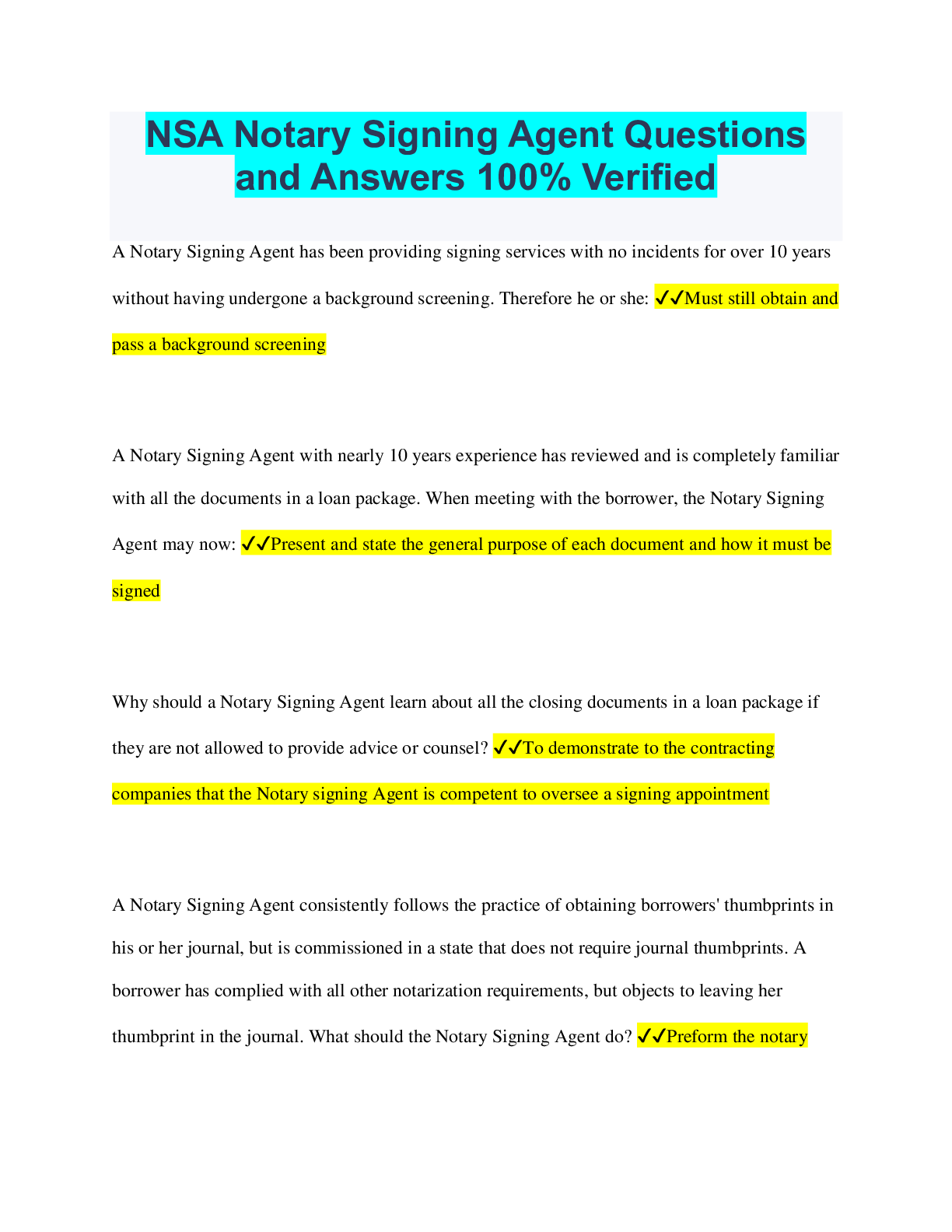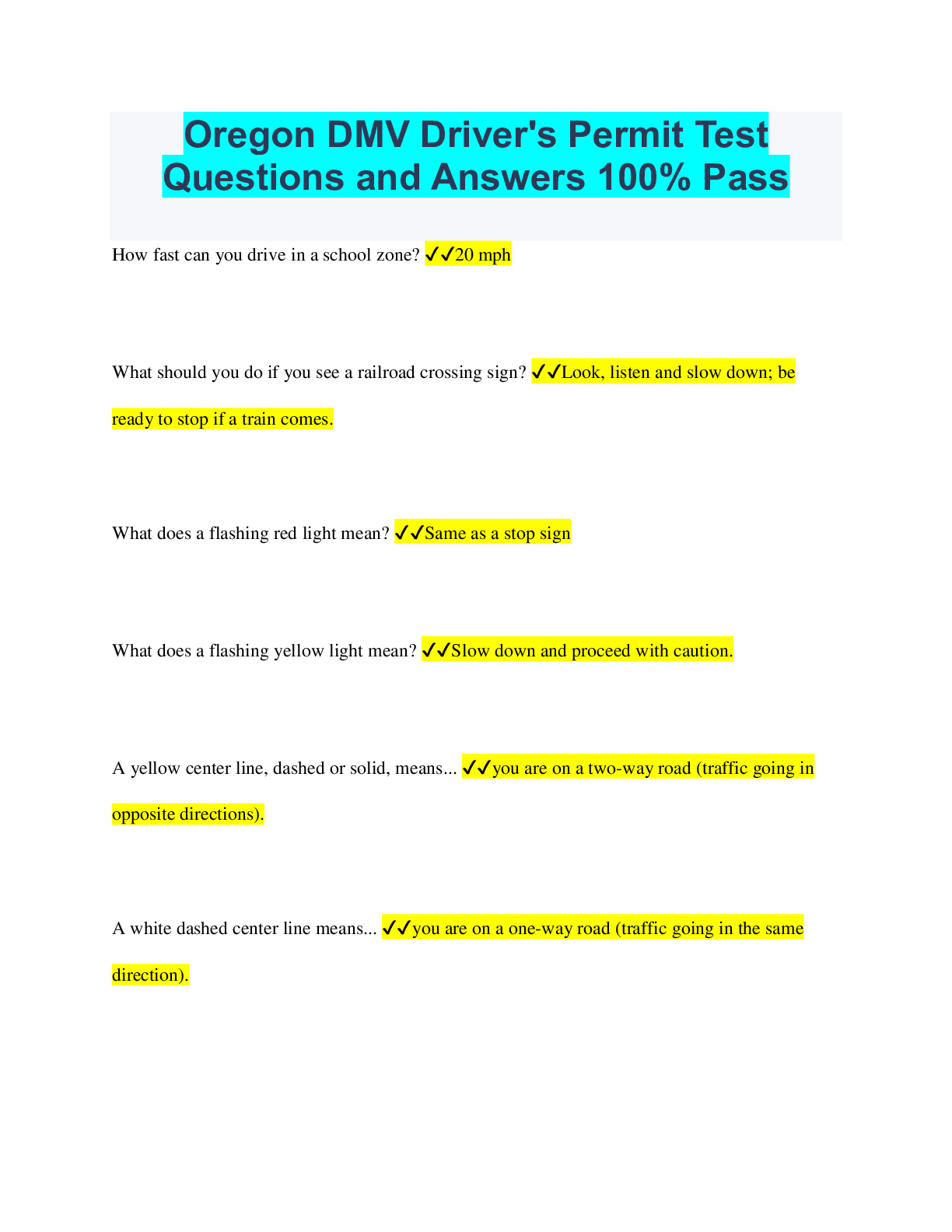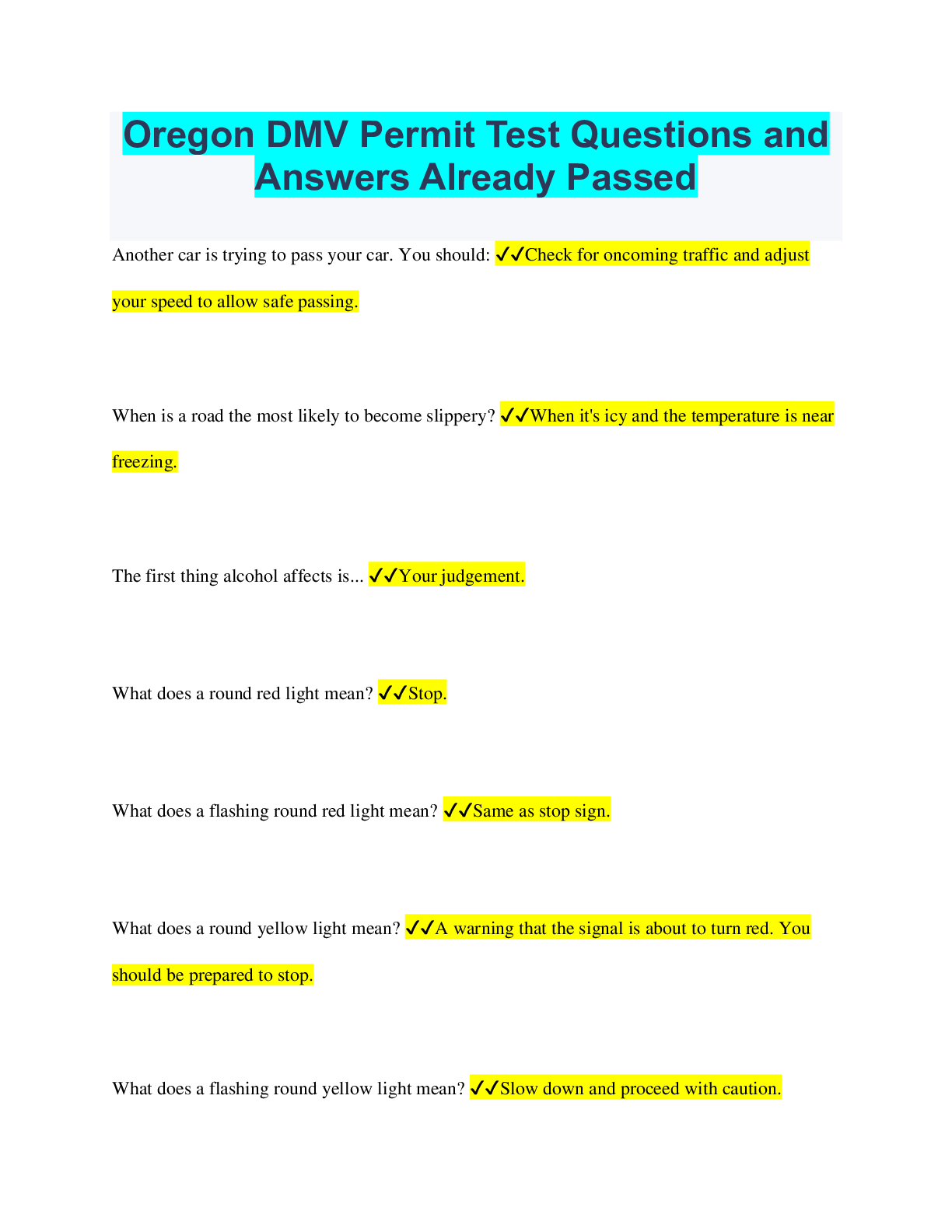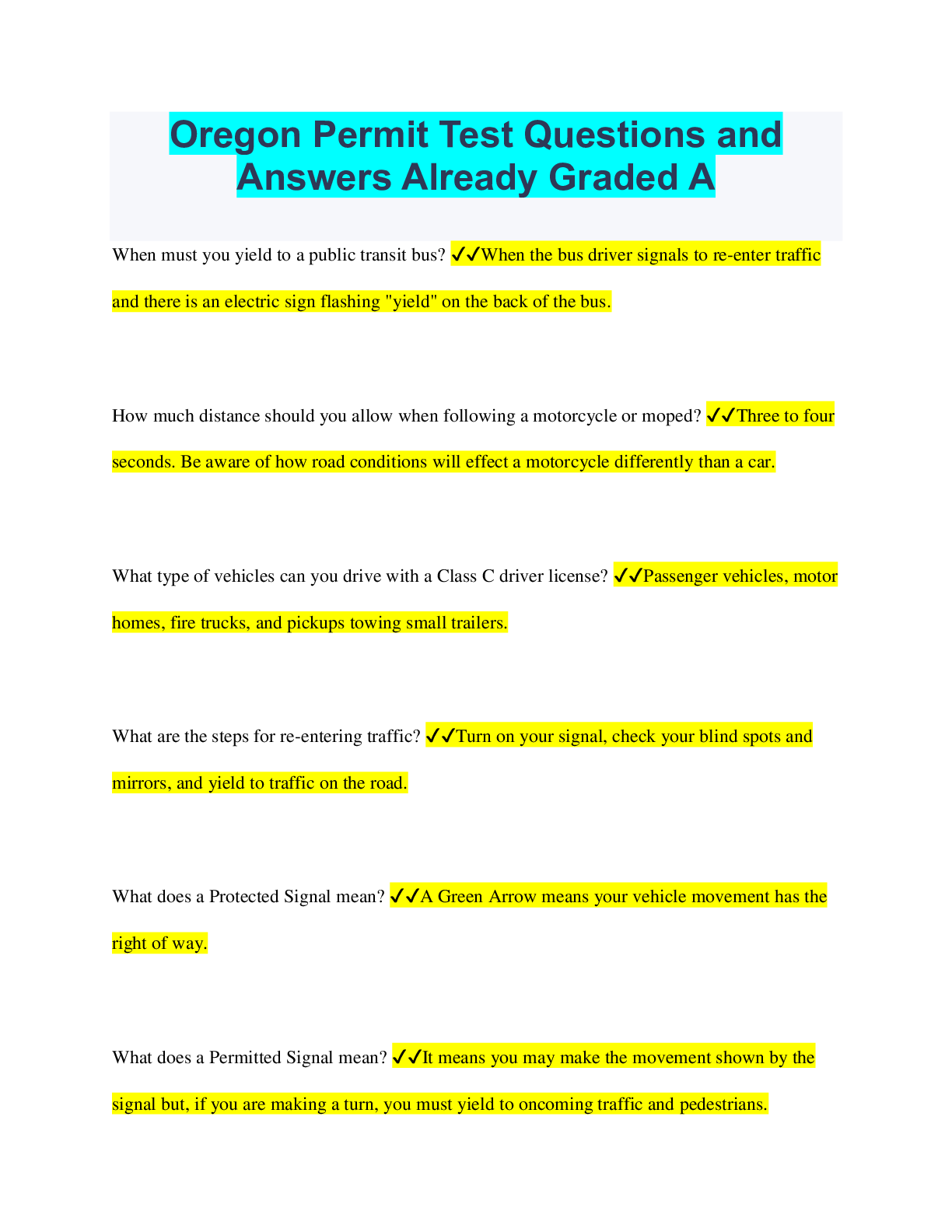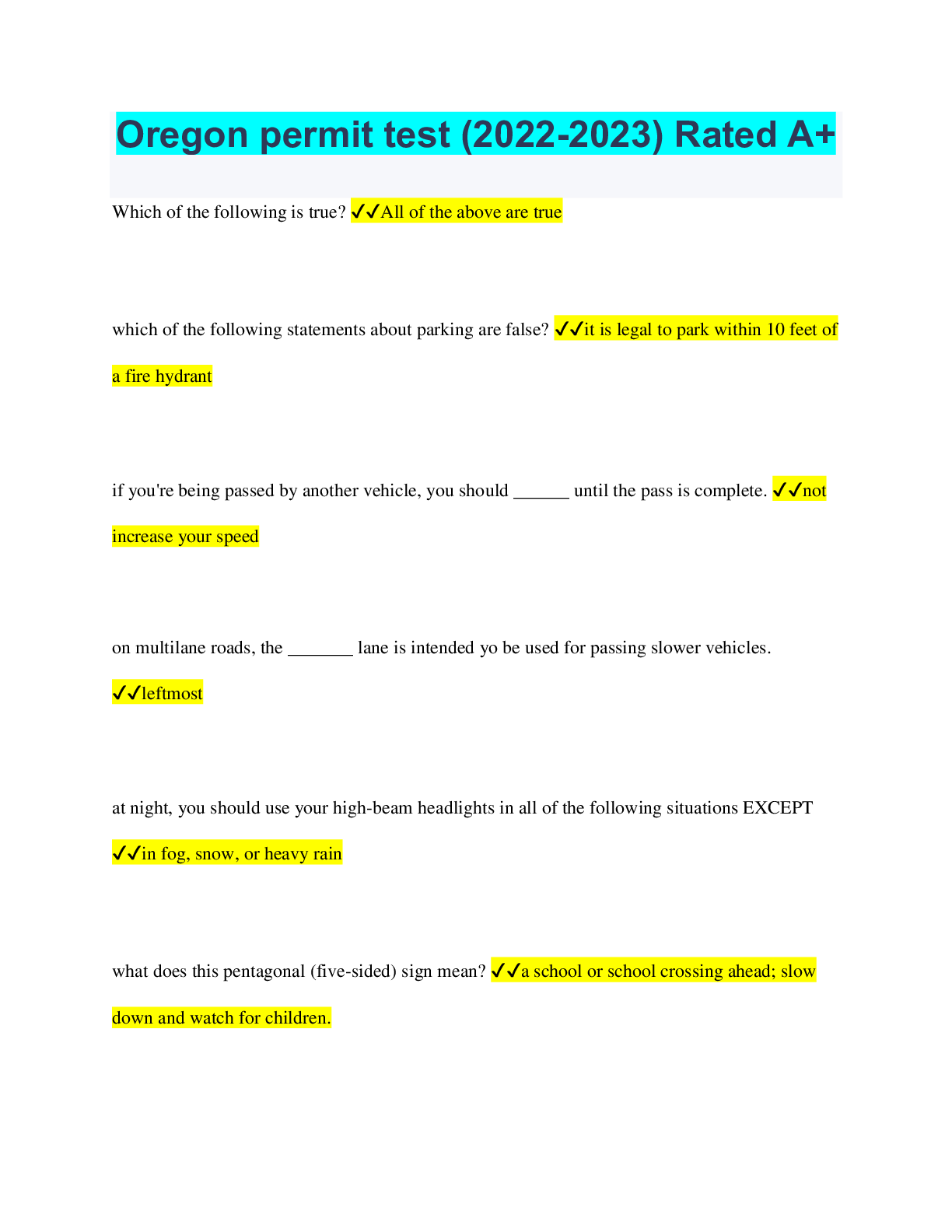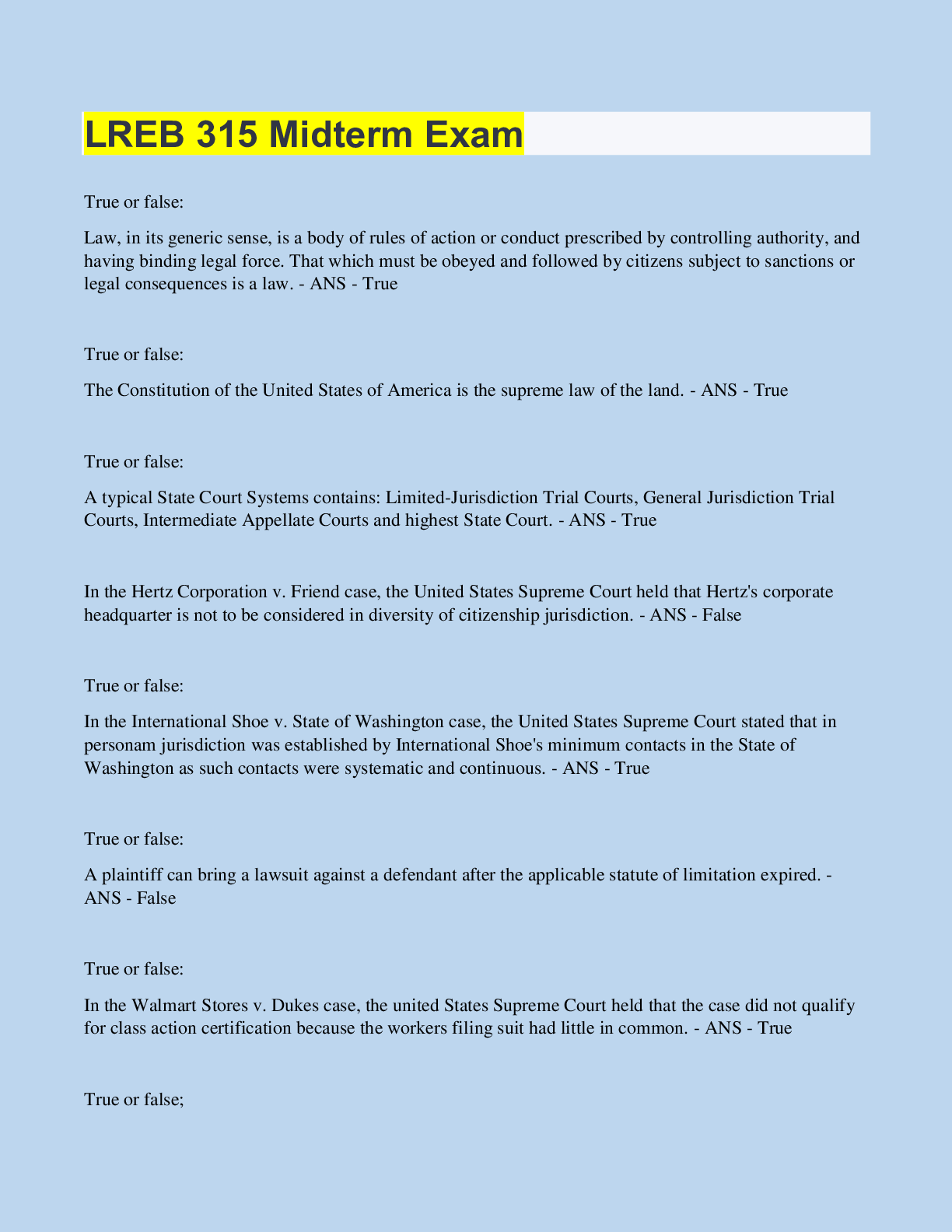Financial Accounting > QUESTIONS & ANSWERS > ACCT 212 Week 8 Homework Questions and Answers Download now to Secure your Grades! (All)
ACCT 212 Week 8 Homework Questions and Answers Download now to Secure your Grades!
Document Content and Description Below
The comparative income statements of Outdoor Music Co. follow: Calculate the change in the income statement amounts from 2017 to 2018. (Use a minus sign or parentheses for a decrease.) Question 1a: ... Compute the dollar amount of change from one period (the base period) to the next. Answer 1a: Explanation 1a: The study of percentage changes from year to year is called horizontal analysis. Remember, to determine the change, subtract the base year amounts (the 2017 amounts) from the current year amounts (the 2018 amounts). Question 1b: Divide the dollar amount of change by the base-period amount. (Use a minus sign or parentheses for a decrease. Round percentage changes to the nearest one-tenth percent, X.X%.) Answer 1b: Explanation 1b: Let's start by computing the percentage change for total revenue. We need to divide the dollar amount of change for total revenue $(102,000) by the base period for total revenue (remember that the base-period is the 2017 amount or $938,000). Use the formula below to calculate the percentage change. Drive Golf Company's balance sheet at December 31, 2018 is as follows: Question 2a: Perform a vertical analysis of Drive Golf Company's balance sheet to determine the component percentages of its assets, liabilities, and stockholders' equity. (Round the percentages to the nearest hundredth percent, X.XX%.) Answer 2a: Explanation 2a: Vertical analysis shows the relationship of a financial statement item to its base, which is the 100% figure. All items on the financial statement are reported as a percentage of the base. For the income statement, net revenue (net sales) is usually the base. For the balance sheet, total assets is the base number. Suppose under normal conditions a company's gross profit is 50% of revenues. A drop to 40% may cause the company to suffer a loss. Investors view a large decline in gross margin with alarm. Or suppose receivables increases from 20% of assets to 35%; management would want to investigate the reasons why and take corrective action as necessary. These are some of the reasons why vertical analysis is important to management and to investors. The following equation shows how to calculate each balance sheet item relative to the base (total assets). Question 2b: Now, using the formula from above, complete the vertical analysis of the company's remaining balance sheet accounts. The total current asset percentage that we calculated above has been entered for you. (Round the percentages to the nearest hundredthpercent, X.XX%.) Answer 2b: Explanation 2b: Total Current Assets / Total Assets = 43,710/310,000 x 100 = 14.10% Property, plant, equipment / Total Assets = 221,960/310,00 x 100 = 71.60% Other Assets / Total Assets = 44,330/310,000 x 100 = 14.30% Total Assets = 310,000 = 100% Total Current Liabilities / Total Assets = 52,080/310,000 x 100 =16.80 Long-Term Debt / Total Assets = 116,250/310,000 x 100 = 37.50 Total Liabilities / Total Assets =168,330/310,000 x 100 = 54.30 Total Stockholder’s Equity / Total Assets = 141,670/310,000 x 100 = 45.70 Total Liabilities and Stockholder’s Equity = 310,000 = 100% The financial statements of Family News, Inc., include the following items: Question 3a: Calculate the Current ratio. (Round the ratio to two decimal places.) Answer 3a: Explanation 3a: The current ratio makes it easier to compare working capital amounts from firm to firm when you are trying to determine a company's ability to pay its current liabilities with its current assets. The higher the current ratio, the better the ability the business has to pay its current liabilities. Question 3b: Calculate the Quick (acid-test) ratio Answer 3b: (Abbreviations used: ST = short-term and Cash* = cash and cash equivalents. Round the ratios to two decimal places.) Explanation 3b: The quick (acid-test) ratio shows whether a business could pass the "acid test" of paying all its current liabilities if they came due immediately (quickly). This ratio uses a narrower base to measure liquidity than the current ratio does. The higher the acid-test ratio, the better the company's ability to pay its current liabilities should they come due immediately. Using the information given, calculate the acid-test ratio for 2018 and 2017. Question 3c: Calculate the Inventory turnover. (Round the ratios to two decimal places.) Answer 3c: Explanation 3c: Inventory turnover measures the number of times a company sells its average inventory during a year. To compute inventory turnover we must divide cost of goods sold by average inventory for the period. We have been given the cost of goods sold amount, but we will have to calculate the average inventory using the information provided. A fast turnover indicates ease in selling inventory where a low turnover indicates difficulty. Go ahead and complete the table below to calculate inventory turnover for 2018 and 2017. Note: To Calculate Average inventory see example below: Current Year Inventory + Prior Year Net Receivables / 2 = (44,000 + 67,000)/2 = 55,500 Question 3d: Calculate the days inventory outstanding (DIO). (Round the ratios to two decimal places.) Answer 3d: Explanation 3d: Days inventory outstanding (DIO) is calculated by dividing the number of total days in the year by the inventory turnover. This ratio tells us how many days it took the company to turn its entire inventory. Calculate Family's days inventory outstanding. Question 3e: Calculate the accounts receivable turnover. (Round the ratios to two decimal places.) Answer 3e: Explanation 3e: Accounts receivable turnover measures a company's ability to collect cash from its customers. To compute accounts receivable turnover we must divide net credit sales by average receivables. The higher the ratio, the better because it means that the company is able to turn their receivables into cash quickly. We have been given the amount of net credit sales, but we will have to calculate the average receivables using the information given. Go ahead and complete the table below to calculate accounts receivable turnover. Note: To Calculate average net receivables see example below: Current Year Net Receivables + Prior Year Inventory/ 2 = (44,000 + 67,000)/2 = 55,500 Question 3f: Calculate the (DSO). (Round your answers to one decimal place, X.X.) Answer 3f: Explanation 3f: Once the turnover ratio is computed, it is converted to DSO by dividing it into 365 (days per year). In the case of the DSO ratio, we are calculating the number of days it takes to collect the average level of receivables. The lower the ratio, the better because it means that the company is not holding a significant amount of its sales in receivables at any given time. Go ahead and complete the table below to calculate days' sales outstanding. Question 3g: Calculate the Accounts payable turnover Answer 3g: Explanation 3g: Accounts payable turnover measures the number of time per year a business pays off an average accounts payable. To compute accounts payable turnover, divide cost of goods sold by average accounts payable. Note: To Calculate average accounts payable see example below: Current Year accounts payable + Prior Year accounts payable / 2 = (70,000 + 45,000)/2 = 57,500 Question 3h: Calculate the Days' payable outstanding (DPO). (Round to one decimal place, X.X.) Answer 3h: Explanation 3h: Days' payable outstanding is calculated by dividing the number of total days in the year by the accounts payable turnover. This ratio tells us how many days it took for the company to pay off its entire accounts payable balance. Calculate Family's days' payable outstanding. Question 3i: Calculate the cash conversion cycle (in days) Answer 3i: Explanation 3i: Cash conversion cycle measures the amount of time each dollar is tied up in the production and sales process before it is converted into cash through sales to customers. It is calculated by adding the company's days inventory outstanding (DIO) and days sales outstanding (DSO) and then subtracting days payables outstanding (DPO). Question 3k: As a manager of this company, what would you try to improve next year? Answer 3k: The factors that need the most improvement are inventory turnover and cash collections. The company needs to make more sales and keep less inventory on hand, as well as tighten collection policies. This will provide more cash that can be used to pay off payables more quickly. Houle Furniture Company has asked you to determine whether the company's ability to pay its current liabilities and long-term debts improved or deteriorated during 2018. Question 4a: Calculate the company's 2018 and 2017 net working capital. Answer 4a: Explanation 4a: Net working capital measures the ability to pay current liabilities with current assets. In general, the larger the working capital, the better the ability to pay debts. Remember that current assets are those assets expected to be used within a one-year period. Note: Total current liabilities is already provided as a part of the exercise, but you will have to calculate total current assets for 2018 and 2017 using the following: Formula: Current Assets – Current Liabilities = Net Working Capital Question 4b: Calculate the company's 2018 and 2017 Current ratio. (Round the ratios to two decimal places, X.XX.) Answer 4b: Explanation 4b: The current ratio makes it easier to compare working capital amounts from firm to firm when you are trying to determine a company's ability to pay its current liabilities with its current assets. In general, a higher current ratio indicates a stronger debt-paying ability. Formula: Current Assets/Current Liabilitiesv = Current Ratio Question 4c: Calculate the company's 2018 and 2017 quick (acid-test) ratio. (Cash* = cash and cash equivalents. Round the ratios to two decimal places, X.XX.) Answer 4c: Explanation 4c: The quick (acid-test) ratio shows whether a business could pass the "acid test" of paying all its current liabilities if they came due immediately (quickly). This ratio uses a narrower base to measure liquidity than the current ratio does. The higher the acid-test ratio, the better the company's ability to pay its current liabilities should they come due immediately. Formula: (Cash + Short Term Investments + Net Receivables)/Current Liabilities = Quick Ratio Question 4d: Calculate the company's 2018 and 2017 debt ratio. (Round the ratios to two decimal places, X.XX.) Answer 4d: Explanation 4d: The debt ratio tells us the proportion of a company's assets financed with debt. A debt ratio of 1 reveals that debt has financed all assets. A debt ratio of 0.50 tells us that debt finances half of the assets. The higher the debt ratio, the greater the pressure to pay interest and principal. The lower the debt ratio, the better. Use the data provided to complete the calculations below. Note: Total liabilities is equal to total current liabilities + Long Term Debt as shown in the example below. Question 4e: Calculate the company's 2018 and 2017 Times-interest-earned ratio. (Round the ratios to one decimal place, X.X.) Answer 4e: Explanation 4e: Analysts use the times-interest-earned ratio to relate income to interest expense. This ratio measures the number of times operating income can cover a company's interest expense. A high times-interest-earned ratio indicates ease in paying interest, where a low ratio suggests difficulty. The higher the ratio, the better. Question 4f: Summarize the results of your analysis. Answer 4f: Remember that the working capital, current and quick (acid-test) ratios indicate the company's ability to pay its current liabilities. The higher each of these ratios, the better. Recall that both the debt and time-interest-earned ratios indicate the company's ability to cover its longterm debt. The lower the debt ratio and the higher the times-interest-earned ratio the better. The comparative income statements and additional data for Harmon Decor, Inc., follow: Question 5a: Calculate the return on sales for 2018 and 2017. (Round your answers to three decimal places, X.XXX, and do not enter in percentage format. Ignore interest expense in your analysis.) Answer 5a: Explanation 5a: Return on sales shows the percentage of each sales dollar earned as net income. Subtract preferred dividends from net income because the preferred stockholders have a prior claim to their dividends. The higher the return on sales, the more income the company is generating with each dollar of sales. The higher the ratio, the better. Formula: (Net Income – Preferred Dividends)/ Net Sales = Return on Sales Question 5b: Calculate asset turnover for 2018 and 2017. Answer 5b: Explanation 5b: Asset turnover measures the amount of net sales generated for each dollar invested in assets. The higher the asset turnover, the more efficiently management is operating the company. The higher the ratio, the better. We have been given net sales, but we will have to calculate the average total assets using the following formula: Formula: (Beginning Total Assets + Ending Total Assets)/2 = Average Total Assets Formula: Net Sales / Average Total Sales = Asset Turnover Question 5c: Calculate ROA for 2018 and 2017. (Round your answers to three decimal places, X.XXX, and do not enter in percentage format.) Answer 5c: Explanation 5c: Return on assets (ROA) measures how successful a company is in using its assets to earn a profit. We have been asked to use DuPont analysis for ROA. The higher the ROA, the better the company's ability to generate profits with its assets, so the higher the ratio the better. We have already calculated rate of return on sales and asset turnover, the two component ratios of ROA. Formula: Return on Sales x Asset Turnover = Return on Assets (ROA) Question 5d: Calculate the leverage ratio 2018 and 2017. (Round your answers to three decimal places, X.XXX, and do not enter in percentage format.) Answer 5d: Explanation 5d: The leverage ratio, or equity multiplier, measures the proportion of each dollar of assets financed with stockholders' equity. Since total assets - stockholders' equity = total liabilities, the leverage ratio is a way of inversely expressing the debt Ratio it merely looks at financing from the other side of the fundamental accounting equation. We will have to calculate the average common equity using the following formula: Formula: Average Total Assets / Average Common Stakeholders Equity = Leverage Ratio Question 5e: Calculate ROE for 2018 and 2017. (Round your answers to three decimal places, .XXX, and do not enter in percentageformat.) Answer 5e: Explanation 5e: Return on common stockholders' equity, often referred to as return on equity (ROE), measures how much income is earned for every dollar invested by the company's common shareholders. We have been asked to use DuPont Analysis for ROE. The higher the ROE, the more income the company is generating for every dollar invested, so the higher the ratio the better. See below for DuPont Analysis for ROE. Formula: ROA x Leverage Ratio = ROE Question 5F: Compute the gross profit percentage for 2018 and 2017. (Round your answers to two decimal places, X.XX, and do not enter in percentage format.) Answer 5F: Explanation 5F: Gross profit shows the percentage of profit that a company makes from merely selling the product, before any other operating costs are subtracted. [Show More]
Last updated: 2 years ago
Preview 1 out of 14 pages

Buy this document to get the full access instantly
Instant Download Access after purchase
Buy NowInstant download
We Accept:

Reviews( 0 )
$9.50
Can't find what you want? Try our AI powered Search
Document information
Connected school, study & course
About the document
Uploaded On
Aug 02, 2021
Number of pages
14
Written in
Additional information
This document has been written for:
Uploaded
Aug 02, 2021
Downloads
0
Views
82

.png)


